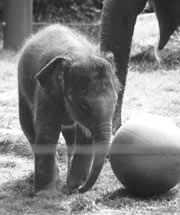I’VE SEEN RAIDERS CAPS in Vietnam and bootlegged Michael Jackson tapes in rural Cambodia. In Brazil, I tried (unsuccessfully) to buy a kid’s T-shirt without an English inscription. But globalization and the homogenization it brings never really came home to me until I was sitting in a garden outside the Brazilian city of Aracaju, surrounded by tropical exotica. Toads and lizards scurried below, and monkeys supposedly scampered overhead. And then I gasped, with the shock of the familiar: The air was filled with the same brash, tuneless cheep-cheep that you and I hear every day in Seattle. Here was the same gray-bellied, chestnut-backed, black-masked little bird that rules our backyards and urban habitats from Norway to New Zealand: the inescapable house sparrow.
“English sparrow,” we call the little bugger in this country. In Italy, where it swarms in churchyards and train stations, it’s passaro italiano, “Italian sparrow.” In the Azores it’s pardal-comun, “common sparrow.” In Brazil it’s called pardal-domestico and assumed to have always been there. But it is native to none of these lands, nor to hundreds of others it inhabits on every continent except Antarctica. It’s not related to the sonorous American sparrows with which it’s often confused (and which it has superseded in many habitats). For years it was classified among the Old World weaver finches, until the classifiers discovered it didn’t fit there either and set it off on its own.
The “English” sparrow appears to have originated in Eastern Africa or the Middle East—where, as if by coincidence, the human species and human civilization also developed. It spread across Europe and Asia over the past 20,000 years—again, right in step with civilization. Most likely, the sparrows evolved into global conquerors through many millennia of association with us. So adapted are they now that they not only tolerate human presence, they seem scarcely able to live without it. Get away from the sparrows’ urban haunts, into the country, and you’ll see not a one of them.
In contrast with the true weaver birds (which, naturally, weave splendid nests), these “weaver finches” are mass slobs, heaping up rough twig piles that a good wind might blow off a branch. But they needn’t build better, because they build in eaves, cornices, attics, and other shelter that we kindly provide. Or they simply appropriate the nests (and destroy the eggs and infants) of bluebirds, wrens, and other, meeker, birds.
Yes, these are street-fighting birds, with a street fighter’s eye out for danger: “Extremely wary,” The Encyclopedia of Birds calls them, “despite the long association with man.” Or, rather, wary because of that association; sparrows have learned to watch out for humans and their cats and cars. And they thrive on the grains that we hosts-with-the-most grow so profusely. Try a simple test, if you haven’t already: Fill a backyard feeder with black sunflower seeds—the expensive spread—and wait for the native chickadees, finches, and juncos. Switch to cheap supermarket bird feed, containing mostly millet and other grains, and English sparrows will crowd the others out.
IT’S A PITY THE 19TH-CENTURY civic boosters who first brought house sparrows to this continent weren’t aware of their dietary preference. The sparrow’s arrival wasn’t quite as pretentious as the first importation of European starlings (by a bibliophile who decided America should have all the birds mentioned in Shakespeare’s plays, released 100 starlings in Central Park, and darkened the reputation of bibliophiles forever), but it was still a stunning act of ecological hubris. The first house sparrows were brought to Brooklyn in the early 1850s to combat cankerworms; over the next 30 years one Midwestern city after another imported these prolific supposed bug eaters. “It was a sign of progress, someone observed, like installing gas,” notes a 1986 Smithsonian account of America’s 19th-century “Sparrow Wars.”
But the birds’ eager hosts soon discovered that, while sparrows would catch some worms for their young, they preferred grain—making them major pests. Not only did they despoil grain stores and pillage newly planted fields, they displaced songbirds that really did eat bugs, bringing on tussock moth epidemics. Cities and states began paying bounties for dead sparrows, while the forerunners of today’s environmentalists and animal-rights advocates debated the Sparrow Issue with a fervor worthy of the old abolitionist debates. Charles Pickering of the Boston Society of Natural History, who first sounded the sparrow alarm, noted that “when writing was invented the sparrow was selected for the hieroglyphic signifying enemy.” The great ornithologist Elliott Coues called sparrows “sturdy little foreign vulgarians.” A founder of the ASPCA called Coues “a murderer.” Henry Ward Beecher accused Coues of “treason” for inciting anti-sparrow riots and thundered, “He shall be surrounded by swarms of sparrows, darkening the sky.” The young naturalist Theodore Roosevelt was likewise rebuked for noting that he’d seen sparrows assaulting songbirds and even killing a sapsucker, and farmers shooting them in Egypt.
Quaint as this uproar sounds today, it shows how severe and unexpected an impact a single imported species can have on wild and human life. And it was all for naught; once the bird was out of the cage, extermination campaigns failed, and the sparrows spread along their merry way, reaching California by 1875. Americans, like everyone else, proceeded to take the sparrows for granted, just as we do brown rats, dandelions, influenza, and scores of other “sturdy foreign vulgarians” we’ve wittingly or unwittingly imported.
Sparrows are big winners in the biological trade wars—an unprecedented process of ecological globalization. Its end can only be imagined, but it looks unmistakably and unimaginably dreary: a world of far fewer species and much more narrow interactions, in which survival will depend foremost on the ability to live in, with, or around human beings. According to a study reported in Bioscience (8/98), competition or predation by non-native species is a factor in 49 percent of threatened extinctions in this country.
“Invasive species” is usually the label for such biological conquistadors, but I like the evocative (if not precisely equivalent) term biologists use to describe the prolific, fast-spreading species that crop up around newly disturbed patches of rain forest: supertramps. As tramps go, the house sparrow is truly super—probably the world’s most numerous bird, outnumbering even starlings and rock-dove “pigeons.”
What more suitable fellow traveler could we have in our worldwide conquests than this brash and brazen bird? It’s big-brained and adaptable. It’s relentlessly fertile, not to say oversexed; one 19th-century birder, seeing two sparrows copulate 14 times in quick succession, declared that the male of the species suffers “from satyriasis and the female from nymphomania.” It’s ruthless and fearless, and treats rival species exactly as the Israelites treated the Canaanites and the Europeans treated America’s Indians and Australia’s aborigines. In short, it’s just like us. If we were birds, we wouldn’t be eagles. We’d be sparrows.







